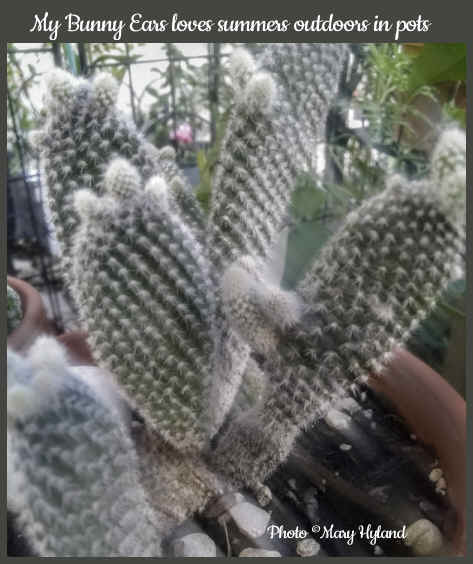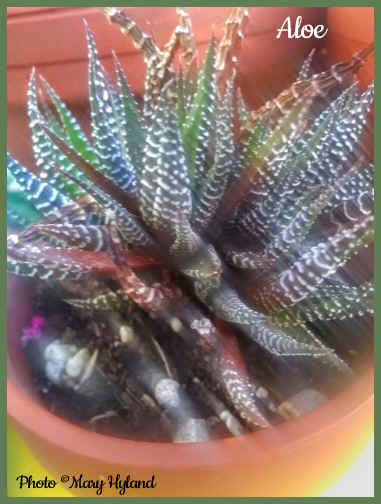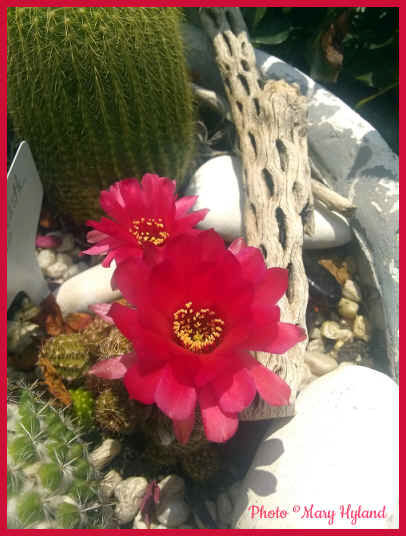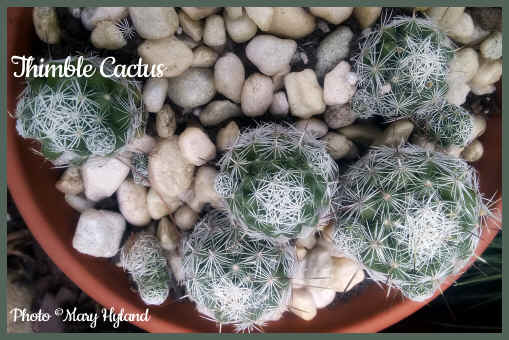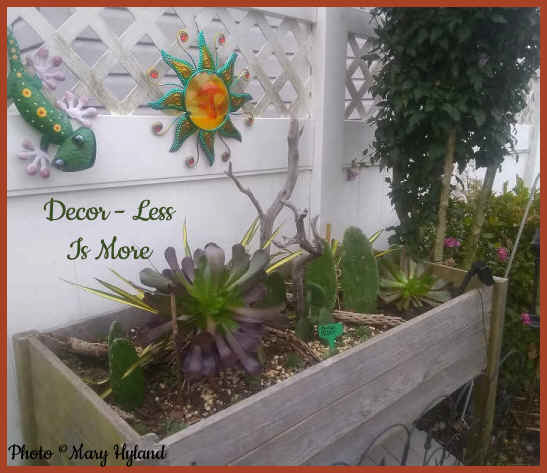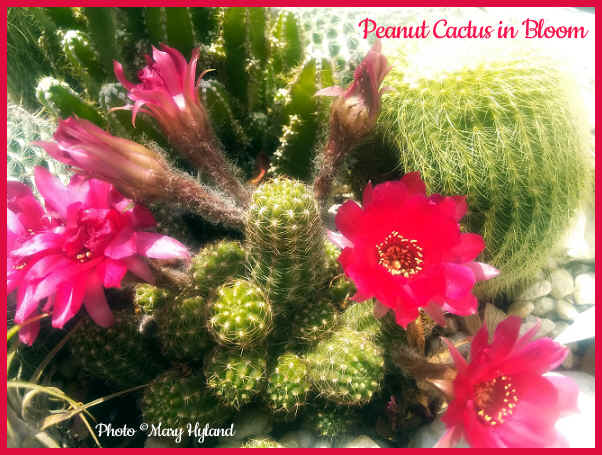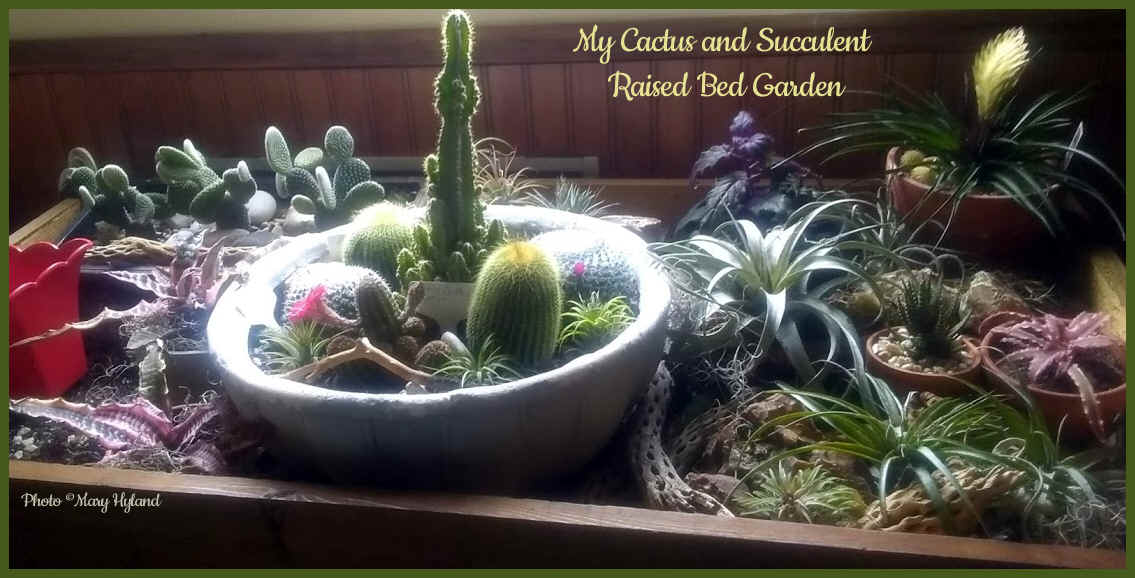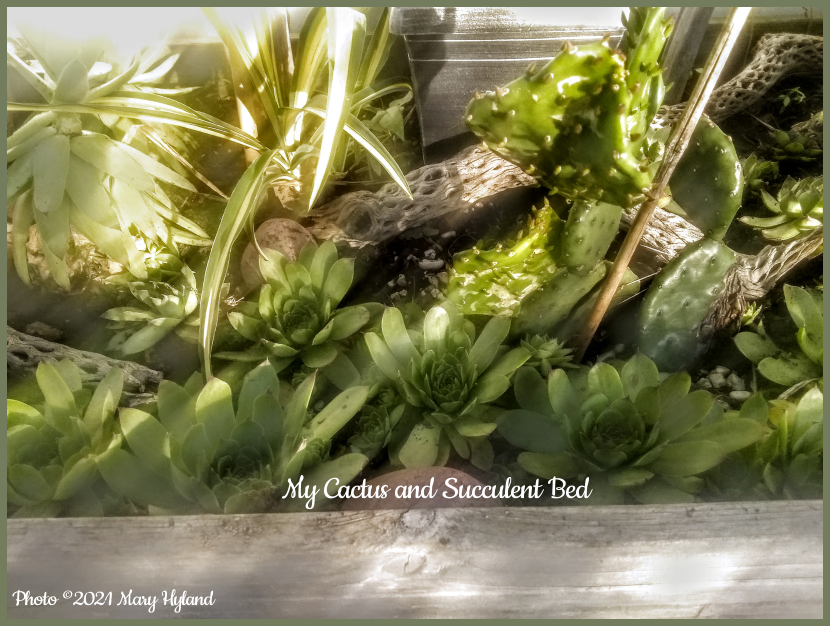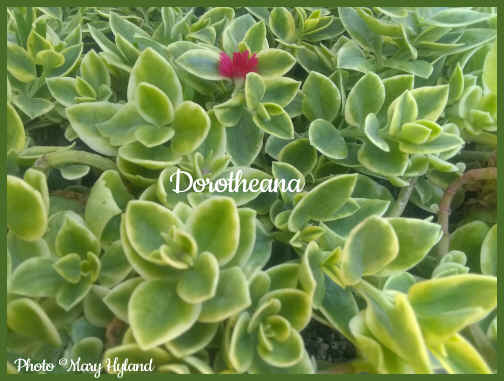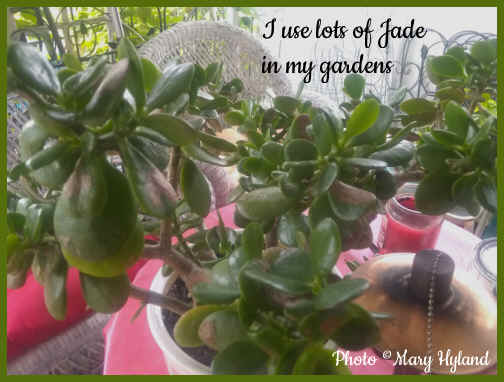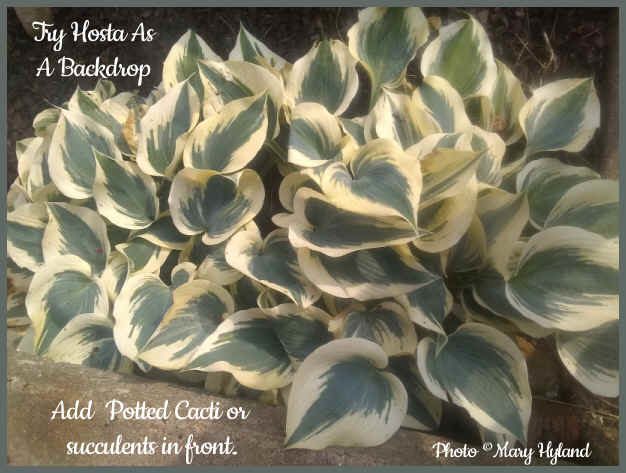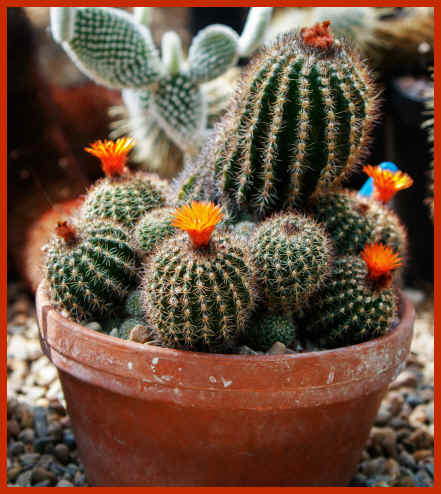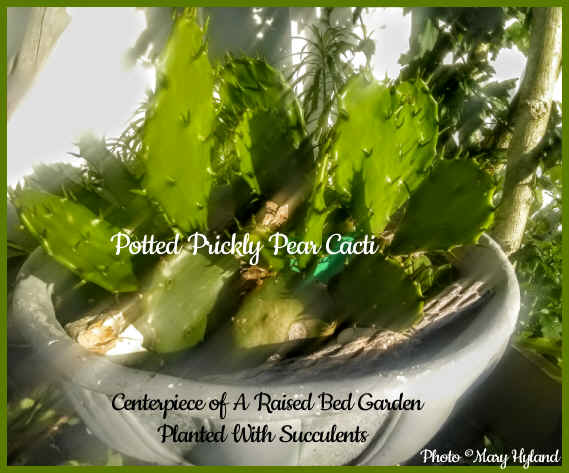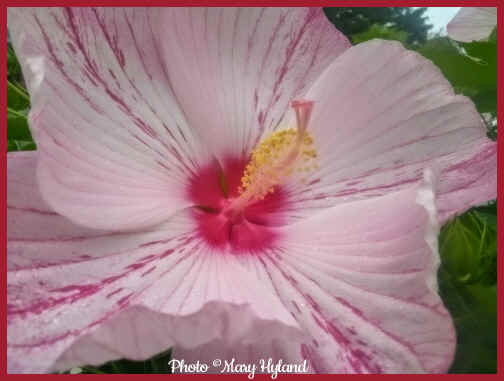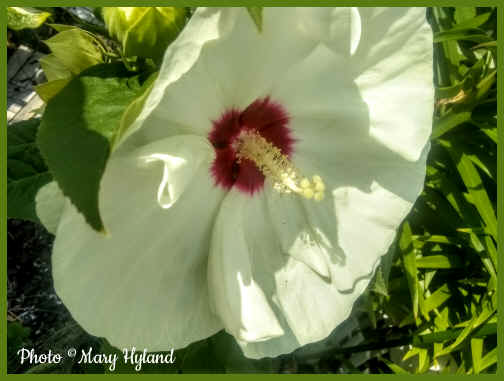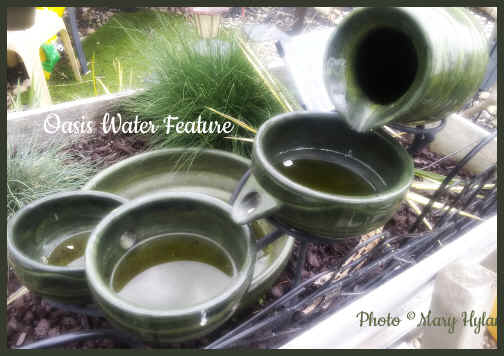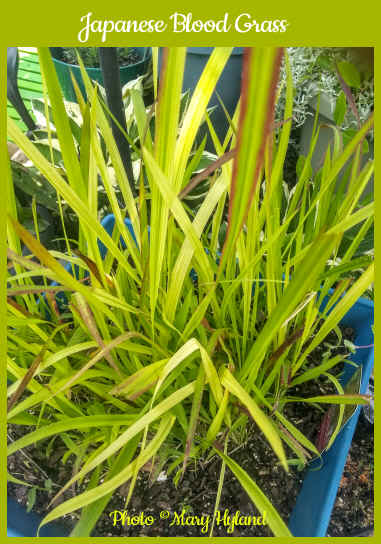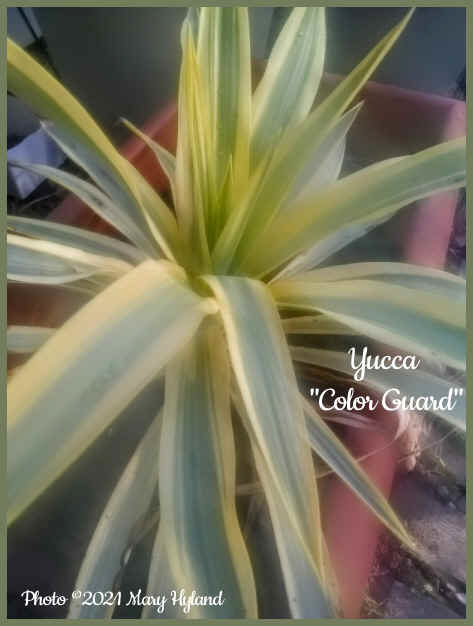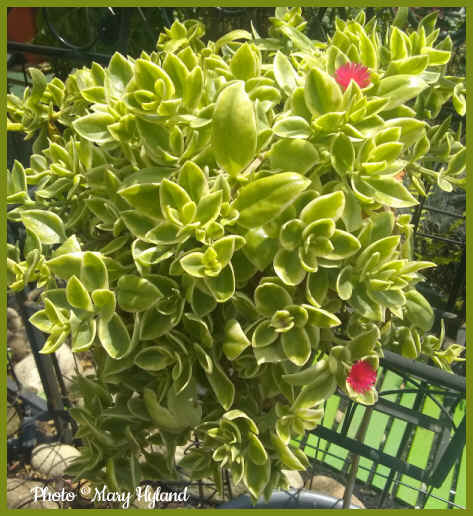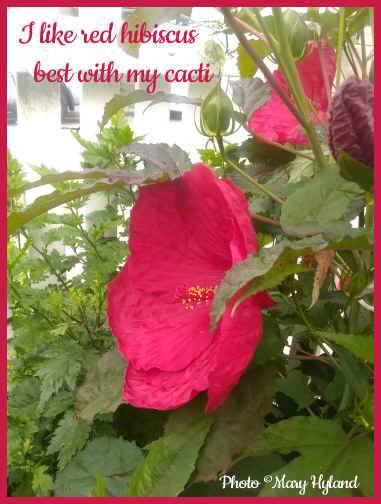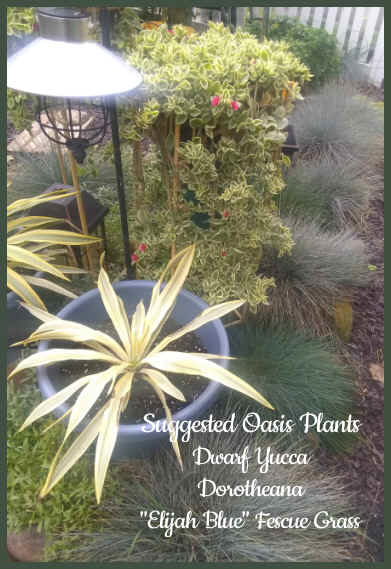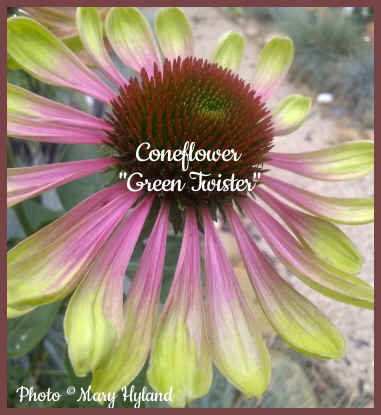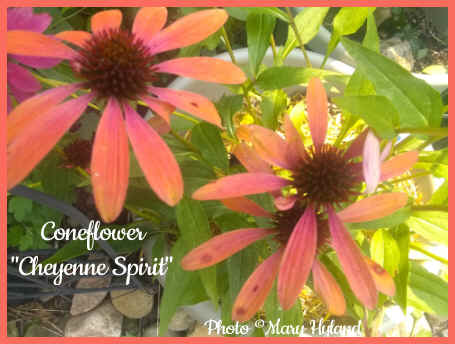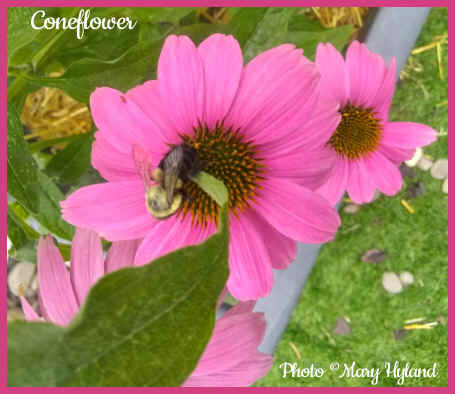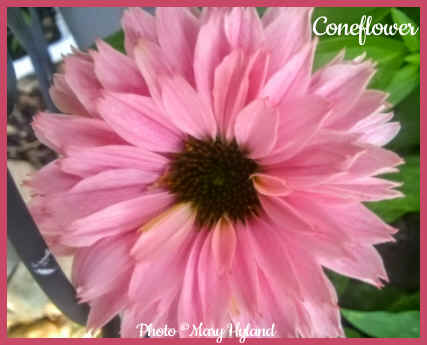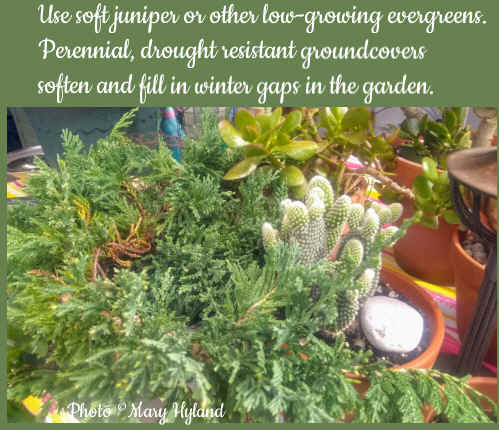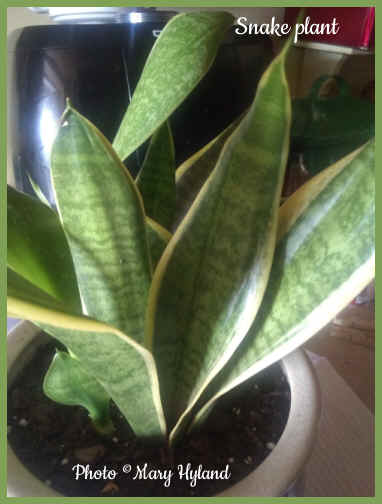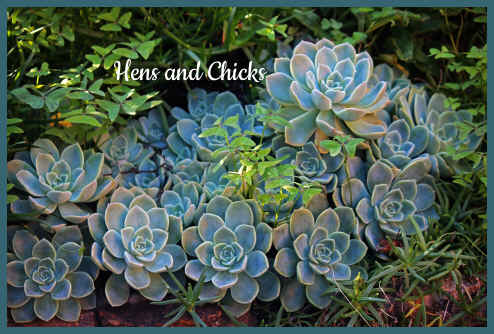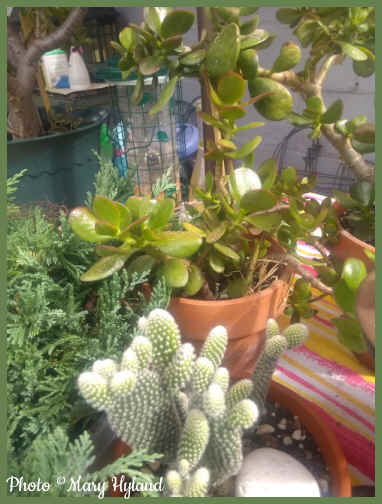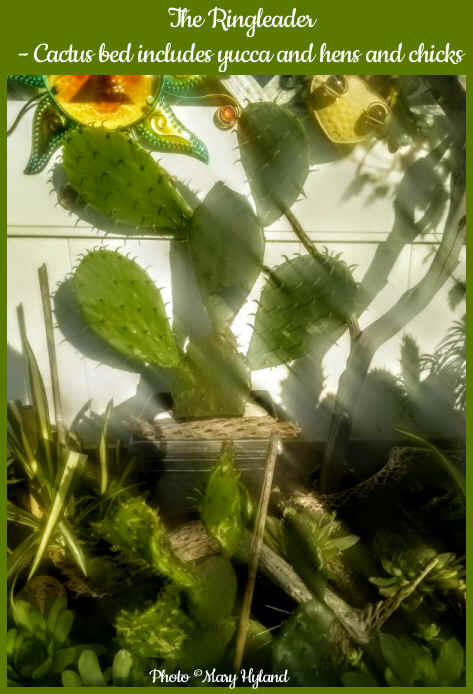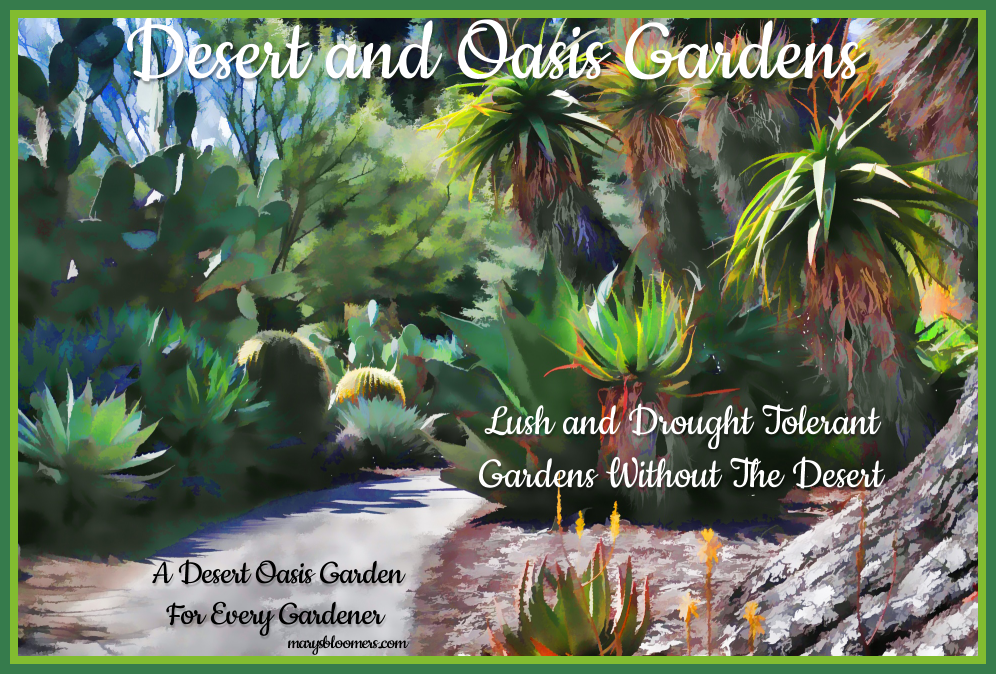 |
Please be patient while a ton of photos loads..... An addition of a desert or dry
garden combination design with lush greenery adds a lot of interest to a
secluded or out of-the-way spot in the garden, or it can be the entire
garden. Except for caring for and adding foliage and unusual plant
accents to it, I don't even call it gardening. Because it's generally
not a cooperative, inviting or happy-feeling theme, and it doesn't
require much of anything. And I've never seen one that makes me want to
sit and put my feet up to enjoy a cup of tea. They're very beautiful in
a Look But Don't Touch Me kind of way. So I'd add small plantings to my
existing garden space.
You want to plant your cactus garden and forget it, because working with cactus is not for the timid when it comes to maintenance. You want to plant it and leave it alone. Potted plants can be brought into the house for winter. Try to grow the garden in such a way that you don't need to get physical with the plants. It's not user-friendly, so gardeners like me, who are constantly re-decorating and moving things in the garden, will have to settle on the types of plants and a spot it's going to permanently inhabit. Or plant it in easy-to-care for groupings in big raised beds and moveable planters. Someplace that won't need to be weeded. Except for dividing and propagating or removing more growth, there's no need to work with them at all. I occasionally have to prop some up with branches or stones just for making them grow where and how I want them. There's a similarity between desert gardens and xeriscaping - any drought tolerant plants can be in a xeriscape, including the cactus. The desert garden features the plants that grow with almost no water, except for the seasonal rains, and the design feels and looks dry, with the addition of groundcover, cactus branches, areas of sand or rocks that give that illusion. My next desert design will be to add a bog or small clay bowl fountains to "cool off" the visuals. There's also a similarity to the "southwestern garden" design, if the decor and pots you use are a defined southwestern style. I like to mix it up and avoid patterns in a desert garden. I like adding a funky decor piece, like a sculpture of a creature that lives in desert areas, but decor is kept at a minimum. My groupings are highlighted or back dropped by my privacy fence. It's a bright canvas and reflects sunshine. The lattice top is a natural for leaning or hanging ornamental pieces and tall plants.
A desert garden is not meant to be warm and fuzzy or welcoming. They're beautiful, but I don't feel any zen when I look at them. But you can add rough and rustic-style wood and accent bamboo benches and iron or stone tables to create a seating area for enjoyment of the garden. Adding lush, green potted foliage plants and some that flower and have fragrance, and blending them in with the succulents and cactus plants makes it more welcoming, if you wish to sit in the desert garden. I prefer to have several beds and plantings for visual appeal and an unexpected theme in my existing gardens. I don't sit in mine because by the time I have time to sit, I need the serenity of my Zen Garden. The cactus garden looks best to me in a front yard setting as a focal point. I would place it where pets and children don't frequently visit. Another idea is to have it anywhere, surround space around it with the succulents and foliage plants, and place a seating area within that space. A physical and visual buffer between the seating and the prickly things. The addition of "soft' cacti, like Bunny Ears adds to the softening and welcoming effect. They're cute and fuzzy and a beautiful blue-green shade.
A well-designed desert and oasis garden is a sight to see. Such different plants with amazing shapes and characteristics. The feel of a jungle or rainforest, coupled with a dry and formidable desert look, all at the same time, once the garden is mature. Lush and dry plantings can be placed together or near each other - using the wonder of planting in pots and installing small water features tucked in among the. The addition of pebbles and rocks, driftwood, cholla and manzanita tree branches - they all add to the mystique. As does a large stone or any type of raised planter filled with soil and topped with an arranged layer of sand and black stones, wherein cactus plants reside. All the decorative ornamentation breaks up the monotone green. As does the shapes and features of many of these dry plantings. Who's to say you can't have a small, ornamental cascading fountain or a small floating fountain, or just a dripping bamboo stick fountain in the midst of all that dry and austere atmosphere? I think lush and dry themes look stunning together, and if arranged correctly, the space feels almost pre-historic. Lush plants will give the impression that it's also an oasis. An oasis is a place where water is found, and there's a little patch of green or special flower in the midst of a lot of dry earth gravel or sand. The idea that water is there and creating a tropical, jungle-like and humid atmosphere. The same concepts can be applied if you're growing a desert garden indoors, or housing non-hardy plants for winter. The basis for my desert oasis gardens is shown below in the indoor winter garden bed. The suggested plants are bromeliads, aloe, air plants, bunny ears, mammillaria and barrel cactus, fairy castle cactus. The planters and pots are sitting on soil, as they do in my outdoor garden..
My desert and oasis garden is simple.....There's not much I can plant in the way of cacti in my outdoor garden that will be hardy, and only Opuntia (Prickly Pear Cactus) winters over in my Zone 6 garden. Many succulents and grasses are hardy. The trick is to make sure drainage is superb so that water doesn't settle in with rot and frozen plant cells to be expected. I lost a few plants, but I know it was because we had a very wet winter and soggy conditions. The plants were confined in raised beds, and I didn't consider a cover over them. My error in judgment. But most of them came back in full force and had a tremendous amount of growth, as well as pretty flowers this summer. They're quite beautiful in a grouping, especially in flower. I add dried cholla cactus branches and sometimes poke small succulents into soil in the holes. I use the hardy cactus and succulents as the basis for my garden design, and all other additions are in pots around them. Along with matching foliage plants for the oasis feel. In the photos below, all cacti and succulents are winter hardy. Yucca, hens and chicks, Prickly Pear Cactus. I use dried cholla cactus branches to separate, prop, and otherwise add decorative interest. I toss small handfuls of stones or pea gravel for ground texture. The bamboo stakes are used when I want to temporarily separate parts of prickly plants from intruding upon others, until they grow in the direction I want them to grow. All are in a large, unpainted elevated cedar garden bed. Bear in mind that all of these different types of plants get the same care - rain when it rains, dry when it's not. There's no extra care involved when planting many different plants together. Except for plants in pots, which do need to be watered more frequently than Never. This means you do not have to have a boring desert oasis bed.
Succulents, on the other hand.... I love them! There are several hardy types that look great growing around and between cactus plants and with gnarly groundcovers like juniper. I like the knobby and twisted features of dwarf groundcover junipers and cedars. Dorotheana, pictured below is a go-to plant in all of the garden beds. It's beautiful foliage gets teeny red flowers, and it drapes and hangs to create a soft touch to your prickly plantings. They are not hardy in zone 6, and they're hard to come by, so I bring them in for winter, and they sit in hanging baskets and clay pots. They're a beautiful houseplant. I put them all back outside in late spring... at the bases of plants in big pots, tumbling from elevated raised beds, and hanging in baskets. They grow pretty quickly and don't ask for much in return, except for a good drink of water now and then. I divide them into more plants as summer and growth progresses. Dorotheana is very neat and tidy, and doesn't seem to be bothered by pests. The leaves are fragile, as with many succulents with jade-like leaves. I'm constantly knocking a few off, but they grow densely and don't seem bothered much. Transplanting/replanting is a challenge because of the fragility of the stems, but they're pretty easy-going and take to their new homes quickly. Hosta - Unlikely companions, but awesome in the desert oasis scheme. It's a beautiful backdrop of leaves behind pots or in-ground plantings. I accidentally discovered it's usefulness in the cooling and softening of rough and hot spaces and plantings. Choose a small variety, and those with variegated foliage that matches your cactus shadings. There's a beautiful "white feather" variety that sets everything off quite nicely. Hosta is hardy in most gardens. Shoots from the dormant tubers will pop up quickly in the spring.
Growing desert plants in pots is a great way to be sure you can bring them indoors for a harsh winter to use as houseplants. The dangers of gardening are all right there in the cactus. Mean and nasty things, and not for the timid. Succulents, like my jade trees and hens and chicks don't scare me. Pointy yucca and aloe plants are no biggie if you wear gloves. But cactus plants, I do fear. Believe me when I say that if you
plant these in big areas outdoors unconfined and have the desire to move
them or repot them someday, it's a painful and time-consuming thing to
move them and re-plant. I use rose pruning gloves that are heavy duty
and up to my elbows. I also use long barbecue tongs. I still manage to
get a lot of those hairy glochids in my hands, on my clothes, and it
takes me hours to remove them (any sticky tape will do the trick).
Those little picky things are torture to endure all day, and you will be
uncomfortable until you remove every one of them. You might get a rash,
as I do. I also unwillingly donate a pint of blood every time I weed or
touch those formidable plants. If I did it all again, this time they'll
all be in portable and moveable pots. There's no way I can manage some
of the larger cacti in beds. Raised or not. The groupings look amazing,
especially with various pots and ornamental pieces added - but it is so
not worth the injuries. Pets may also accidentally brush up against, or
run into, the beds.
Hints: Pot up the plants that will come into the house for the winter in the pots you are going to keep as part of your indoor decor. Don't get pots that have to be switched out, or are too small for your plant, or too heavy to move. Moving and re-potting cacti is messy, time-consuming, and a hazard to you your pets, and your home. Leave the winter hardy plants outside in the beds or pots that they will live in permanently. Terra cotta pots work great, but you can use faux stone-look plastic. As long as there's a drainage hole, the planter shouldn't crack. You can move the hardy outdoor plants to a table or patio to protect them for winter, if you like, and keep them all in one place. Especially if you're covering or somehow winterizing them. You can put them back where you want them in spring. Do NOT use leaves, paper, straw, or organic mulches on or around the cactus plants to winterize - you will deeply regret it when it's time to take that mulch off. If you want to add protection, insert tall bamboo or metal stakes around the plants (taller than the plants) and drape burlap or frost blankets over the plants or entire bed. Lift it off when the sun warms things up in the spring without harming yourself or the plants. It's not necessary to cover hardy cacti and succulents, but some folks like to keep cold and wet away from the plants to avoid rot or cell damage. Be sure to remove all coverings, especially plastic, once the plant shows shoots or growth - the sun will burn the plants, and the plastic keeps too much condensation on the plants, leading to rotting cacti, who don't like wet digs.
You're not going to create a patch of petunias, geraniums, coleus and groundcovers. You will be creating a special place, where only the toughest plant survives hot and dry conditions. Stick with the cacti and succulents. Some succulents and foliage plants have an abundance of beautiful leaves and some do flower. Go for the dry look and skip the bedding and flower border thing. There are some good-looking foliage and spiky-stemmed evergreens, and lots of hummingbird plants that can be incorporated into the theme for color, fragrance, and pollination. The oasis space should look like a refreshing spot of green and flowers, as if there was water in just that little spot. There are many plants that appear to be desert succulents and tough-as-spikes cacti, but they are not. These are valuable in the garden to fill out the design. I also use my indoor Christmas Cactus plants outdoors from spring til fall, and they reward me with year-round flowers. They're very pretty when placed in a stark and mono-colored grouping of plants and with other succulents.. A potted desert garden will have the variety of plants, even though the plants have very separate water needs. Everyone can get along and grow well. The desert part will get very little water above natural rainwater, most succulents need less than the decorative perennials. The perennials can be planted in-ground, and the cactus/succulent can be in pots, where you can regulate their water intake. You can water your perennials and ornamentals, when needed, and not get the dry guys wet or soggy at the same time. If they're in separate raised beds, it's even easier. Ornamental grasses and pond plants are great for adding height and texture and the oasis look. Many are dwarf and can be placed in pots, and lots of them don't mind being dry. There are others that can be part of an oasis with a fountain or pots of water. They live totally in water or in bog gardens. You can really mix it up. A plant in big pot filled with water is not much more work or maintenance than the dry garden. And most of these plants can live in water, around water, or in-ground. I like the flowy look in prickly-feeling areas. They come in all different heights and many color variegations. My ornamental grasses are hardy pond plants in my area, so they can sleep outside in winter. Growing most, if not all, of your cacti, grasses and succulents in pots allows you to cluster and change the look of your garden any time you like. You can grow most ornamentals that are not hardy in your area, and winter them over. Hosta is an awesome addition - It grows from tubers, and it's perennial. It is great in part shade, and there are varieties that can take the heat. There are very large ones, and petite types. Some have very pretty flowers. I use it to edge and soften most areas in my gardens. The only care it gets is that I snip off dead leaves and unattractive flower heads. Jade Plant - These are beautiful no matter where you put them in the garden. They can grow as large shrubs in warm climates, but we pot them and bring them in for winter in the northern states. Awesome succulent house plant. Their pudgy leaves and interesting branching add an Asian feel.
I will leave the choices of cacti and pseudo-cacti to you. Here are ideas for the plants around the prickly beings that highlight, soften or cool off your design and make it more welcoming.. Remember that all cacti are succulents, but not all succulents are cacti. It'll help with placement of your plants in the garden and with devising a watering routine. Cooling, Softening Drought Resistant Oasis Plants That Add Color Bromeliads - Not winter hardy, and can be brought in for winter as houseplants. Beautiful colors and shapes. Some bear spiky and arrow-shaped ornamental flowers that look great with cacti and succulents. Echinacea (Coneflower)
Interesting Companion Plants A desert garden doesn't have to be boring or unwelcoming - many ornamentals can be interspersed and add color to the garden. Sedums - My favorites are
the yellow-green and blue-greens. They are perennial succulents and come
in lots of sizes,, including groundcover. Hens and Chicks I'm repotting and dividing now, so here are some photos of the plants I use for the desert garden theme. Most are low-growing, except for Prickly Pears, Snake Plant, grasses and Jade. Snake plants need shade, so placing it under another plant's canopy is wise.
Quick Links |
Content, graphics,
photos and design ©2020 marysbloomers.com
All rights reserved.
